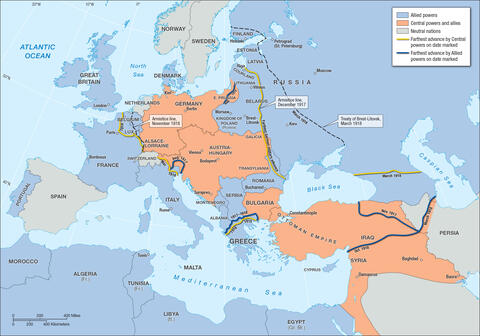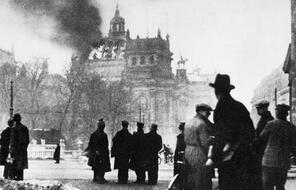The Brutal Realities of World War I
At a Glance
Subject
- History
- Human & Civil Rights
- The Holocaust
Combat and the Colonies: the Role of Race in World War I
In August 1914, both sides expected a quick victory. Neither leaders nor civilians from warring nations were prepared for the length and brutality of the war, which took the lives of millions by its end in 1918. The loss of life was greater than in any previous war in history, in part because militaries were using new technologies, including tanks, airplanes, submarines, machine guns, modern artillery, flamethrowers, and poison gas.
The map below shows the farthest advances of Central and Allied forces on the fronts to the west, east, and south of Germany and Austria-Hungary. Most of the war's major battles took place between those lines of farthest advance on each front. Germany’s initial goal was to knock the French out of the war by occupying Belgium and then quickly march into France and capture Paris, its capital. German troops could then concentrate on the war in the east. That plan failed, and by the end of 1914, the two sides were at a stalemate. Before long, they faced each other across a 175-mile-long line of trenches that ran from the English Channel to the Swiss border. These trenches came to symbolize a new kind of warfare. A young officer named Harold Macmillan (who later became prime minister of Britain) explained in a letter home:
Perhaps the most extraordinary thing about the modern battlefield is the desolation and emptiness of it all. . . . Nothing is to be seen of war or soldiers—only the split and shattered trees and the burst of an occasional shell reveal anything of the truth. One can look for miles and see no human being. But in those miles of country lurk (like moles or rats, it seems) thousands, even hundreds of thousands of men, planning against each other perpetually some new device of death. Never showing themselves, they launch at each other bullet, bomb, aerial torpedo, and shell. And somewhere too . . . are the little cylinders of gas, waiting only for the moment to spit forth their nauseous and destroying fumes. And yet the landscape shows nothing of all this—nothing but a few shattered trees and 3 or 4 thin lines of earth and sandbags; these and the ruins of towns and villages are the only signs of war anywhere.
The glamour of red coats—the martial tunes of fife and drum—aide-de-camps scurrying hither and thither on splendid chargers—lances glittering and swords flashing—how different the old wars must have been. The thrill of battle comes now only once or twice in a [year]. We need not so much the gallantry of our fathers; we need (and in our Army at any rate I think you will find it) that indomitable and patient determination which has saved England over and over again. 1
The area between the opposing armies’ trenches was known as “No Man's Land” for good reason. Fifty years after the war, Richard Tobin, who served with Britain’s Royal Naval Division, recalled how he and his fellow soldiers entered No Man’s Land as they tried to break through the enemy’s line. “As soon as you got over the top,” he told an interviewer, “fear has left you and it is terror. You don’t look, you see. You don’t hear, you listen. Your nose is filled with fumes and death. You taste the top of your mouth. . . . You’re hunted back to the jungle. The veneer of civilization has dropped away.” 2
Unlike the war on Germany’s western front, the war on the eastern front was a war of rapid movement. Armies repeatedly crisscrossed the same territories. Civilians were frequently caught in the crossfire, and millions were evacuated from their homes and expelled from territories as armies approached. On both sides of the conflict, many came to believe that what they were experiencing was not war but “mass slaughter.” A private in the British army explained, “If you go forward, you’ll likely be shot, if you go back you’ll be court-martialed and shot, so what the hell do you do? What can you do? You just go forward.” 3
The carnage was incomprehensible to everyone, as millions of soldiers and civilians alike died. Historian Martin Gilbert details the loss of life:
More than nine million soldiers, sailors and airmen were killed in the First World War. A further five million civilians are estimated to have perished under occupation, bombardment, hunger and disease. The mass murder of Armenians in 1915 [see reading, Genocide Under the Cover of War], and the [Spanish] influenza epidemic that began while the war was still being fought, were two of its destructive by-products. The flight of Serbs from Serbia at the end of 1915 was another cruel episode in which civilians perished in large numbers; so too was the Allied naval blockade of Germany, as a result of which more than three-quarters of a million German civilians died. 4
The chart below provides estimates of the number of soldiers killed, wounded, and reported missing during World War I. Exact numbers are often disputed and are nearly impossible to determine for a variety of reasons. Different countries used different methods to count their dead and injured, and some methods were more reliable than others. Records of some countries were destroyed during the war and its aftermath. Also, some countries may have changed the number of casualties in their official records for political reasons. The numbers of civilians from each country killed during the war are even more difficult to estimate. The numbers in the chart reflect the estimates made by most historians today (see reading, Negotiating Peace in Chapter 3).
World War I Casualties
| Total Mobilized Forces | Killed or Died* | Wounded | Prisoners or Missing | Total Casualties | |
|---|---|---|---|---|---|
| Russia | 12,000,000 | 1,700,000 | 4,950,000 | 2,500,000 | 9,150,000 |
| British Empire | 8,904,467 | 908,371 | 2,090,212 | 191,652 | 3,190,235 |
| France** | 8,410,000 | 1,357,800 | 4,266,000 | 537,000 | 6,160,800 |
| Italy | 5,615,000 | 650,000 | 947,000 | 600,000 | 2,197,000 |
| United States | 4,734,991 | 116,516 | 204,002 | — | 320,518 |
| Japan | 800,000 | 300 | 907 | 3 | 1,210 |
| Romania | 750,000 | 335,706 | 120,000 | 80,000 | 535,706 |
| Serbia | 707,343 | 45,000 | 133,148 | 152,958 | 331,106 |
| Canada | 424,000 | 59,694 | 172,000 | 3,800 | 61,082 |
| Belgium | 267,000 | 13,716 | 44,686 | 34,659 | 93,061 |
| Greece | 230,000 | 5,000 | 21,000 | 1,000 | 27,000 |
| Portugal | 100,000 | 7,222 | 13,751 | 12,318 | 33,291 |
| Montenegro | 50,000 | 3,000 | 10,000 | 7,000 | 20,000 |
| TOTALS | 42,612,810 | 5,211,809 | 13,003,004 | 4,124,890 | 22,165,291 |
| Total Mobilized Forces | Killed or Died* | Wounded | Prisoners or Missing | Total Casualties | |
|---|---|---|---|---|---|
| Germany | 11,000,000 | 1,773,700 | 4,216,058 | 1,152,800 | 7,142,558 |
| Austria-Hungary | 7,800,000 | 1,200,000 | 3,620,000 | 2,200,000 | 7,020,000 |
| Turkey | 2,850,000 | 325,000 | 400,000 | 250,000 | 975,000 |
| Bulgaria | 1,200,000 | 87,500 | 152,390 | 27,029 | 266,919 |
| TOTALS | 22,850,000 | 3,386,200 | 8,388,448 | 3,629,829 | 15,404,477 |
| Total Mobilized Forces | Killed or Died* | Wounded | Prisoners or Missing | Total Casualties | |
|---|---|---|---|---|---|
| Allied Powers | 42,612,810 | 5,211,809 | 13,003,004 | 4,124,890 | 22,165,291 |
| Central Powers | 22,850,000 | 3,386,200 | 8,388,448 | 3,629,829 | 15,404,477 |
| Grand Totals | 65,462,810 | 8,598,009 | 21,391,452 | 7,754,719 | 37,569,768 |
- 1Quoted in Mike Webb and Hew Strachan, From Downing Street to the Trenches: First-hand Accounts from the Great War, 1914–1916 (Oxford: Bodleian Library, University of Oxford, 2014), 180–81.
- 2Quoted in Jasper Copping, “Unseen interviews with WW1 veterans recount the horror of the trenches,” The Telegraph, March 6, 2014, accessed May 4, 2016.
- 3 Quoted in Jonathan Glover, Humanity: A Moral History of the Twentieth Century, 2nd ed. (New Haven, CT: Yale University Press, 2012), 157.
- 4Martin Gilbert, The First World War: A Complete History (New York: Henry Holt and Company, 1994), xv
World War I in Europe and the Middle East

World War I in Europe and the Middle East
World War I was fought between the Central powers and the Allied powers simultaneously on several fronts in western Europe, eastern Europe, and the Middle East.
Connection Questions
- How was war different in World War I? Why did this war result in so many casualties?
- How did the reality of combat in World War I compare to the beliefs and attitudes many Europeans had about war before fighting broke out?
- What did Richard Tobin mean by his statement, “The veneer of civilization has dropped away”?
- How would you describe the mood and tone of the voices of soldiers quoted in this reading?
How to Cite This Reading
Facing History & Ourselves, "The Brutal Realities of World War I," last updated August 2, 2016.








